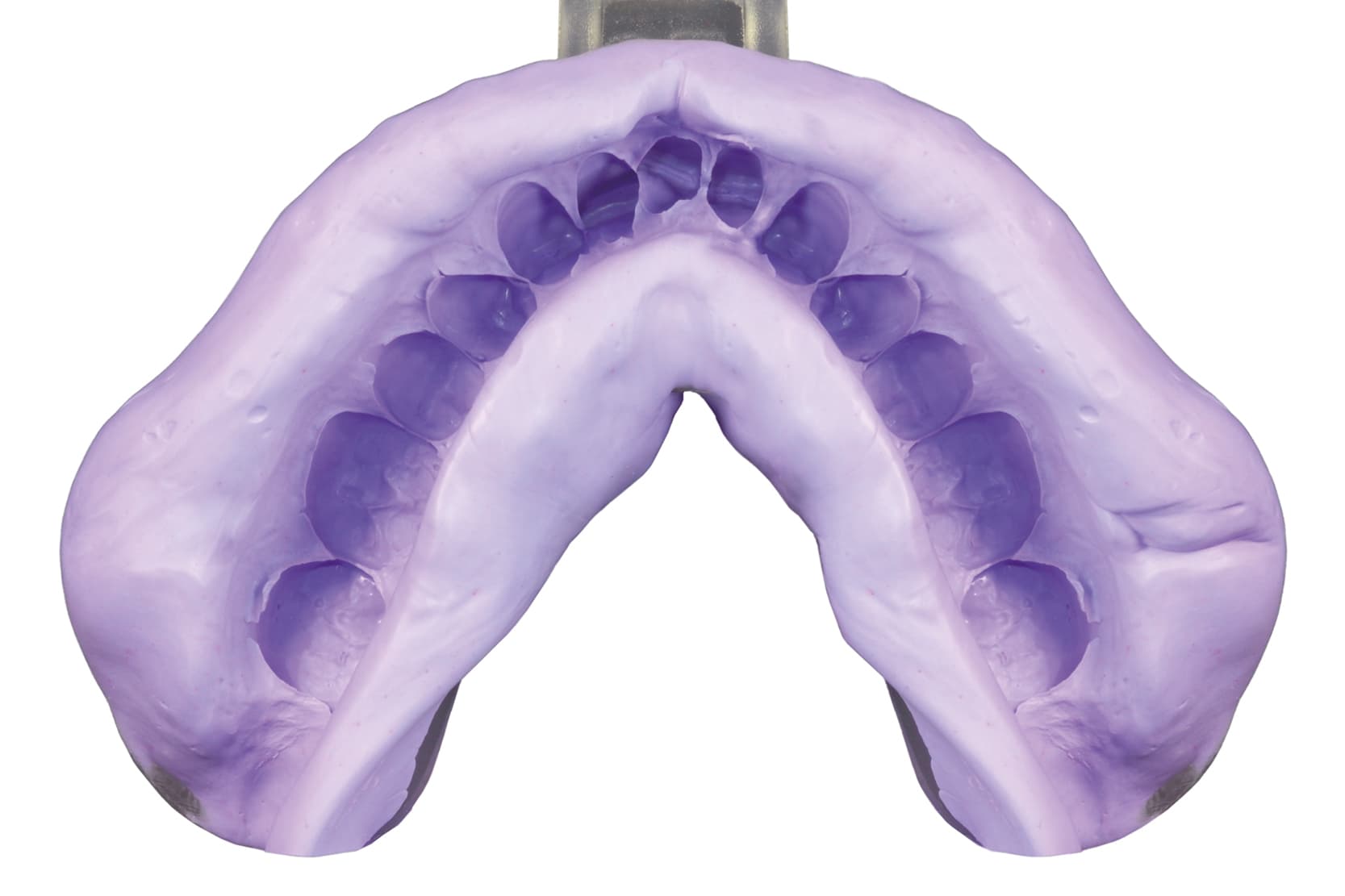
For decades, alginate has been one of the most widely used impression materials in dental practice for study impressions, impressions of opposing arches, impressions for working models in the case of bites, gnathological and orthodontic devices or even for preliminary models in total and partial removable prostheses (1,2).
Alginate is an irreversible hydrocolloid; this means that the water-mediated hydrosol-to-hydrogel reaction, which results in the substitution of sodium ions with calcium ions in the alginate chemical structure, cannot be reversed in any way (1).
Advantages and limitations of alginate in dental treatments
Alginate is valued primarily for its ease of handling: it can be mixed manually with water using a spatula in a bowl, but also using automatic or semi-automatic systems, ensuring versatility and practicality of use (3).
From a clinical point of view, it behaves like a mucostatic material, but by varying the mixing proportions to increase its rigidity, it can assume a mucocompressive behaviour, a useful characteristic in removable prostheses, where the mobile tissues should be stretched on the underlying bone structure (4).
Another significant advantage is its low cost: alginate is available on the market at very affordable prices, both in practical single-dose sachets and in traditional package formats (1).
Furthermore, it is well tolerated by patients, thanks to generally neutral flavours that reduce discomfort during impression taking. Finally, the setting time can vary depending on the type of alginate chosen, allowing the operator to adapt to different clinical needs (5).
The limitations of alginate: stability, strength and operational factors
However, alginate also has some limitations such as its limited dimensional stability. Being a highly hydrophilic material, it is subject to imbibition and syneresis phenomena. This means that just a few minutes after the impression it begins to deform, becoming unusable for most clinical applications within a few days (1,6). There are also alginates today which, in this regard, have of dimensional stability of 5 days, such as Hydrogum 5 or Hydrocolor 5 (7,8).
Furthermore, alginate can be cast only once, without the possibility of replication, making it necessary to repeat the impression in case of damage to the model.
A further limitation is its low tear strength, which leads to a high risk of tearing when removing the material when there are undercuts or interdental areas (9). The disinfection phase also represents a critical issue: prolonged immersion in disinfectant solutions can compromise the dimensional precision and surface quality of the model obtained (10,11).
From an operational standpoint, alginate is influenced by numerous clinical variables, such as powder/liquid ratio, water temperature, mixing method and compatibility with plaster, which may render the clinical outcome less than ideal (1,9,12–14).
The advantages of alginate substitutes: stability, strength and accuracy
To overcome these limitations, so-called “alginate substitutes” have been introduced on the market. These are medium viscosity polyvinylsiloxanes (PVS) that offer the same advantages as traditional PVS at a lower cost.
First of all, their dimensional stability, the highest among all impression materials, even among elastomers (15,16), is noted due to the capacity to be poured more than once (17).
From a mechanical point of view, alginate substitutes present a higher tear resistance and an elastic recovery that approaches 100%, characteristics that allow intact impressions to be obtained even in the presence of pronounced undercuts (18). And, like alginates, they are fully compatible with disinfection protocols, since they do not undergo significant deformations either on immersion or from disinfectant sprays (18).
A particularly important aspect concerns the accuracy of the occlusion with the antagonist model. By using the same material (PVS) for final impressions, bite registrations and opposing models, the risk of dimensional misalignments that can occur when combining PVS registrations with models obtained from alginate is eliminated (19).
Furthermore, the wear resistance of plaster models must also be taken into account. Models obtained from alginate impressions are generally cast with type III plasters, which have limited mechanical characteristics in terms of surface hardness and abrasion resistance (14,20).
Impressions taken with PVS, in contrast, allow the use of type IV plasters, which have superior physical and mechanical properties (17,21). These characteristics are particularly important in the verification and possible occlusal correction phases of the restorations, as they guarantee greater dimensional stability and reduced model wear during laboratory procedures.
Finally, impressions made with alginate substitutes offer a smoother and more detailed reproduction of surfaces, allowing for more accurate and defined models and therefore a reduced need for retouching (19).
Why choose alginate substitutes in clinical practice?
In conclusion, although alginate is still a widely used material today due to its ease of use and low cost, superior dimensional stability, mechanical resistance and reproducibility mean that polyvinylsiloxane-based alginate substitutes represent a valid alternative, with more reliable results and more efficient management of clinical and laboratory processes compared to alginate impressions.
The cost of these materials, which is slightly higher than that of alginate, is therefore more than compensated by the advantages.
Zhermack offers Freealgin, an alginate substitute that overcomes the limits of traditional materials: it offers precision up to 20 microns, dimensional stability for up to 15 days and immediate scannability without opacifiers. Ready to use in self-mixing cartridges, it reduces waste and optimises convenience in the practice.
References:
1. Cervino G, Fiorillo L, Herford AS, Laino L, Troiano G, Amoroso G, et al. Alginate Materials and Dental Impression Technique: A Current State of the Art and Application to Dental Practice. Mar Drugs. 2018 Dec 29;17(1).
2. Dilip A, Gupta R, Geiger Z. Dental Alginate Impressions. In: StatPearls. Treasure Island (FL): StatPearls Publishing; 2021.
3. Frey G, Lu H, Powers J. Effect of mixing methods on mechanical properties of alginate impression materials. J Prosthodont. 2005 Dec;14(4):221–5.
4. Alqattan WA, Alalawi HA, Khan ZA. Impression Techniques and Materials for Complete Denture Construction. Dental Health: Current Research. 2017 Jan 2;2016.
5. Dreesen K, Kellens A, Wevers M, Thilakarathne PJ, Willems G. The influence of mixing methods and disinfectant on the physical properties of alginate impression materials. European Journal of Orthodontics. 2013 Jun 1;35(3):381–7.
6. Ibrahim AA, Alhajj MN, Khalifa N, Gilada MW. Does 6 Hours of Contact With Alginate Impression Material Affect Dental Cast Properties? Compend Contin Educ Dent. 2017 Jun;38(6):e1–4.
7. Hydrogum 5 [Internet]. Zhermack. Available from: https://www.zhermack.com/it/product/hydrogum-5-it/
8. Hydrocolor 5 [Internet]. Zhermack. Available from: https://www.zhermack.com/it/product/hydrocolor-5-it/
9. Inoue K, Song YX, Kamiunten O, Oku J, Terao T, Fujii K. Effect of mixing method on rheological properties of alginate impression materials. J Oral Rehabil. 2002 Jul;29(7):615–9.
10. Sharif RA, Abdelaziz KM, Alshahrani NM, Almutairi FS, Alaseri MA, Abouzeid HL, et al. The accuracy of gypsum casts obtained from the disinfected extended-pour alginate impressions through prolonged storage times. BMC Oral Health. 2021 Jun 9;21(1):296.
11. King BB, Norling BK, Seals R. Gypsum compatibility of antimicrobial alginates after spray disinfection. J Prosthodont. 1994 Dec;3(4):219–27.
12. Hamilton MJ, Vandewalle KS, Roberts HW, Hamilton GJ, Lien W. Microtomographic Porosity Determination in Alginate Mixed with Various Methods. J Prosthodont. 2010;19(6):478–81.
13. Sayed ME, Gangadharappa P. Three-dimensional evaluation of extended pour alginate impression materials following variable storage time intervals and conditions. Indian J Dent Res. 2018 Aug;29(4):477–86.
14. Murata H, Kawamura M, Hamada T, Chimori H, Nikawa H. Physical properties and compatibility with dental stones of current alginate impression materials. J Oral Rehabil. 2004 Nov;31(11):1115–22.
15. Gonçalves FS, Popoff D a. V, Castro CDL, Silva GC, Magalhães CS, Moreira AN. Dimensional stability of elastomeric impression materials: a critical review of the literature. Eur J Prosthodont Restor Dent. 2011 Dec;19(4):163–6.
16. Nassar U, Oko A, Adeeb S, El-Rich M, Flores-Mir C. An in vitro study on the dimensional stability of a vinyl polyether silicone impression material over a prolonged storage period. J Prosthet Dent. 2013 Mar;109(3):172–8.
17. Heidari B, Vafaei F, Izadi A, Saleh A, Dehbani Z, Khazaei S. Effect of Contact Time Between Silicone Impression Materials and Stone on Dimensional Stability of Resultant Cast. Avicenna J Dent Res. 2013 Jun 25;5(1):20–5.
18. Gothwal G, Meena S, Padiyar UN, Sharma HK, Kaurani P, Singh DP. Comparative evaluation of elastic recovery of three different elastomeric impression materials on chemical disinfection and autoclaving: An in vitro study. J Indian Prosthodont Soc. 2019 Dec;19(4):345–52.
19. Boksman AL, DDS, FADI, Tousignant FG, CDT. Glidewell. Alginate Substitutes: Rationale for Their Use.
20. Morrow RM, Brown CE, Stansbury BE, deLorimier JA, Powell JM, Rudd KD. Compatibility of alginate impression materials and dental stones. J Prosthet Dent. 1971 May 1;25(5):556–66.
21. Millstein PL. Determining the accuracy of gypsum casts made from type IV dental stone. J Oral Rehabil. 1992 May;19(3):239–43.
Would you like more information about Zhermack Dental products and solutions?
Contact us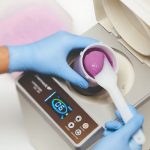
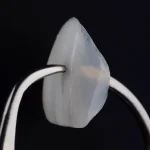
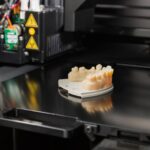
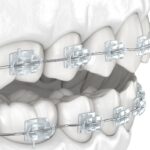
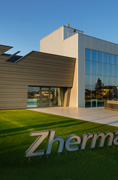
 Zhermack SpA has been one of the most important producers and international distributors of alginates, gypsums and silicone compounds for the dental sector for over 40 years. It has also developed solutions for the industrial and wellbeing sectors.
Zhermack SpA - Via Bovazecchino, 100 - 45021 Badia Polesine (RO), Italy.
Zhermack SpA has been one of the most important producers and international distributors of alginates, gypsums and silicone compounds for the dental sector for over 40 years. It has also developed solutions for the industrial and wellbeing sectors.
Zhermack SpA - Via Bovazecchino, 100 - 45021 Badia Polesine (RO), Italy.


